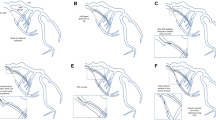Abstract
The retrograde approach via native channels, mainly septal collaterals, has now become routine. However even after retrograde advancement of a catheter through a collateral channel, it is sometimes difficult to guide the catheter from a false lumen into the true lumen. We experienced 3 patients in whom the site for retrograde guidewire re-entry site from the chronic total occlusion was unclear, and intravascular ultrasound (IVUS) was useful for identifying the re-entry site. Here we report on this new technique, in which IVUS guides the retrograde guidewire to its re-entry site.







Similar content being viewed by others
References
Muramatsu T, Hirano K, Tsukahara R, et al. Long-term outcome of percutaneous transluminal coronary intervention for chronic total occlusion in the BMS era in Japanese. Cardiovasc Interv Ther. 2010;25:78–84.
Kahn JK, Hartzler GO. Retrograde coronary angioplasty of isolated arterial segments through saphenous vein bypass grafts. Catheter Cardiovasc Diagn. 1990;20:88–93.
Silvestri M, Parikh P, Roquebert PO, et al. Retrograde left main stenting. Catheter Cardiovasc Diagn. 1996;39:396–9.
Roy PR, Steinberg DH, Sushinsky SJ, et al. The potential clinical utility of intravascular ultrasound guidance in patients undergoing percutaneous coronary intervention with drug-eluting stents. Eur Heart J. 2008;29:1851–7.
Di Mario C, Barlis P, Tanigawa J, et al. Retrograde approach to coronary chronic total occlusions: preliminary single European centre experience. Euro Interv. 2007;3:181–7.
Saito S. Different strategies of retrograde approach in coronary angioplasty for chronic total occlusion. Catheter Cardiovasc Interv. 2008;71:8–19.
Rathore S, Katoh O, Matuso H, et al. Retrograde percutaneous recanalization of chronic total occlusion of the coronary arteries. Circ Cardiovasc Interv. 2009;2:124–32.
Sianos G, Barlis P, Mario CD, et al. European experience with the retrograde approach for the recanalization of coronary artery chronic total occlusions. A report on behalf of the Euro CTO Club. Eur Interv. 2008;4:84–92.
Surmely F, Tsuchikane E, Katoh O, et al. New concept for CTO recanalization using controlled antegrade and retrograde subintimal tracking: the CART technique. J Invasive Cardiol. 2006;18:334–8.
Schrale RG, Channon KM, Ormerod OJ. IVUS-guided evaluation and percutaneous intervention in an anomalous left main coronary artery. J Invasive Cardiol. 2007;19:E195–8.
Ito S, Suzuki T, Ito T, et al. Novel technique using intravascular ultrasound-guided guidewire cross in coronary intervention for uncrossable chronic total occlusions. Circ J. 2004;68:1088–92.
Author information
Authors and Affiliations
Corresponding author
Rights and permissions
About this article
Cite this article
Muramatsu, T., Tsukahara, R. & Ito, Y. A novel intravascular ultrasound-guided percutaneous coronary angioplasty technique via the retrograde approach for chronic total occlusion. Cardiovasc Interv and Ther 26, 45–51 (2011). https://doi.org/10.1007/s12928-010-0033-0
Received:
Accepted:
Published:
Issue Date:
DOI: https://doi.org/10.1007/s12928-010-0033-0




